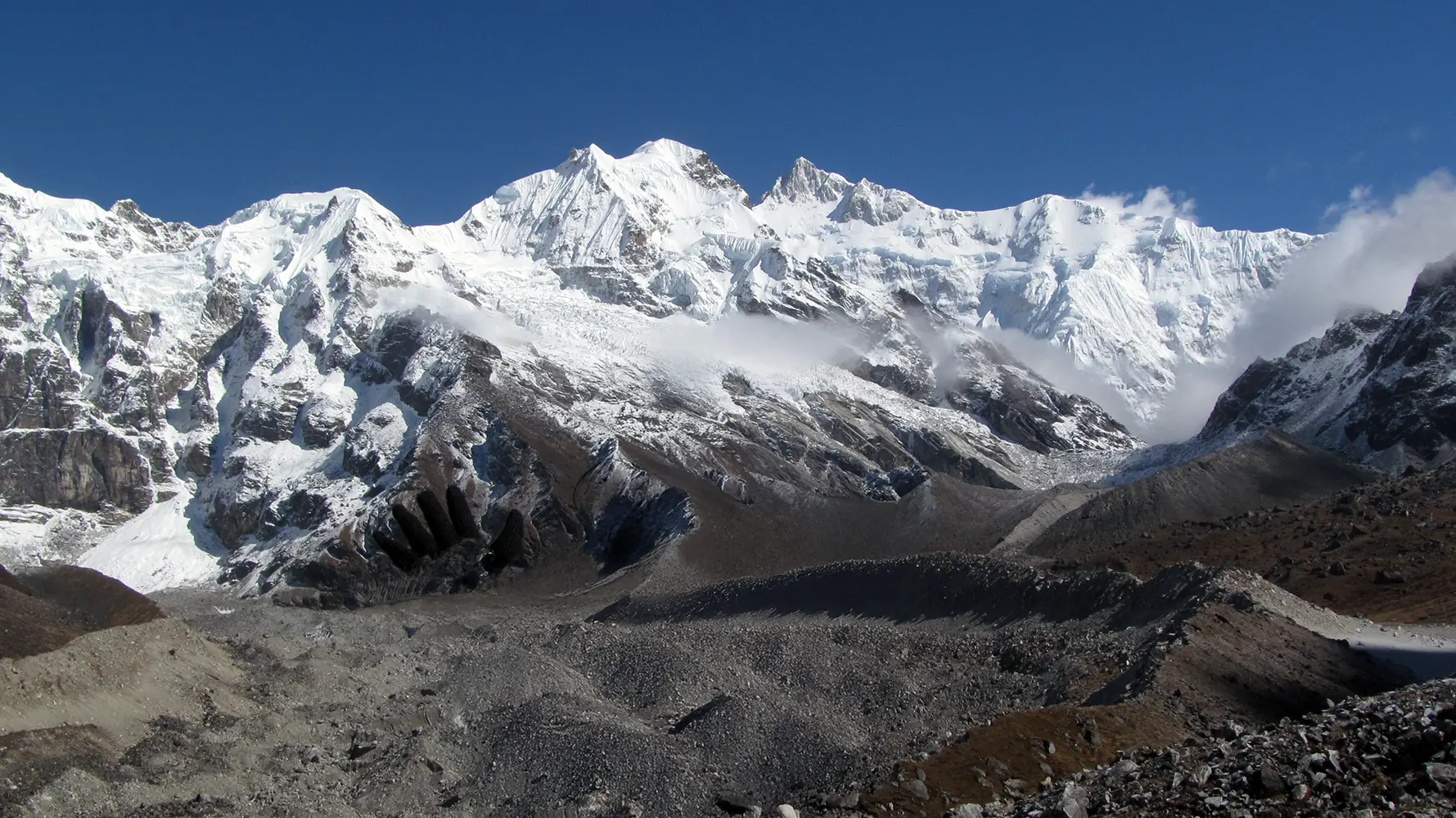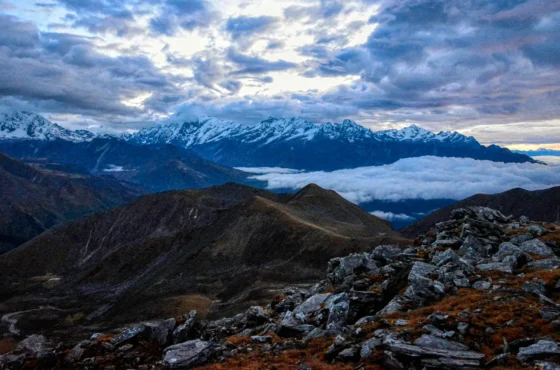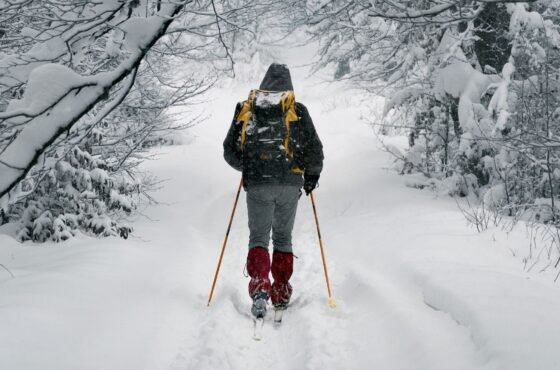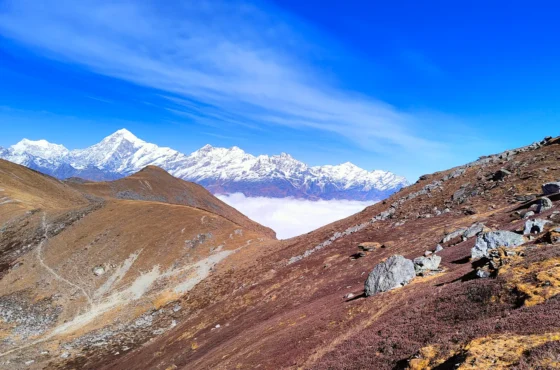The Goechala Trek is a high mountain pass in Sikkim, India, offering breathtaking views of Kanchenjunga, the world’s third-highest peak. Starting from Yuksom West Sikkim, this epic journey winds through the pristine Kanchenjunga National Park, delivering an unmatched Himalayan adventure.
What makes this trek truly special? Unlike other Indian treks, this route brings you within touching distance of towering giants. You don’t just see one summit — but 14 other big peaks. The trek passes through Kanchenjunga National Park, a UNESCO World Heritage Site spanning over 2,035 square kilometres of pristine wilderness.
The Goechala Trek stands apart from others in India for key reasons. First, it’s home to indigenous communities like the Bhutia, Lepcha, Tsong Limbu, and Nepali, creating a unique backdrop that’s both wild and culturally rich. The challenging landscape offers diverse terrain that changes dramatically as you climb through dense forests, crystal-clear lakes, and blooming rhododendrons.
The highlight is the viewpoint at Goechala pass, situated at 4,940 meters (16,200 feet). From here, trekkers enjoy panoramic views of Kanchenjunga, Pandim, and the surrounding Himalayan ranges. The famous sunrise views from Dzongri Top create magical moments that stay with you forever.
This 81-kilometre, eight-day moderate-to-difficult trek demands good fitness and prior experience. But it rewards adventurers with views so stunning they reportedly inspired India’s currency design. Whether you’re drawn by close-up mountain views, rich rhododendron forests, or the spiritual high-altitude experience, the Goechala Trek offers an adventure that’s hard to match anywhere else in India.
Cost Includes & Excludes
Cost Includes
- Accommodation - Twin-sharing tents and guesthouse stay
- All meals - Breakfast to dinner (vegetarian + eggs)
- Professional trek leader - Mountaineering and first aid qualified
- Experienced guides - Local high-altitude specialists
- Support staff - Cook, helpers, camp manager
- Camping equipment - Sleeping bags, mattresses, tents, utensils
- Safety gear - First aid kit, oxygen cylinder, stretcher
- Technical equipment - Ropes, helmets, microspikes, gaiters (if required)
- All permits - Forest permits and entry fees for Indians
- Porter/mule service - For carrying group equipment
- Cloakroom facility - For excess luggage at base camp
Cost Excludes
- Transportation - NJP to Yuksom (₹3,000 add-on available)
- Personal porter/mule - For carrying personal luggage
- Offloading service - ₹5,500 if you don't want to carry backpack
- Travel insurance
- Foreign permits - ₹4,000 extra for international trekkers
- Personal expenses - Snacks, beverages, shopping
- Emergency evacuation - Helicopter rescue or hospitalization
- Meals during transit - Food while traveling to/from basecamp
- Equipment rental - Personal gear like shoes, jackets, poles
- Tips for staff - Gratuity for guides and support team
- Any upgrades - Premium accommodation or transport
Trip Info
-
Tents in trek & Hotel/ Homestay in Yuksom
-
Permit Charges
-
Yuksom
-
March,April, May - October - November and Early December
-
New Jalpaiguri (NJP) / Bagdogra / Pakyong Airport
-
Not Available
-
Professional trek leader
-
Not Covered
-
English , Hindi, Nepali
-
4,600 meters
-
Vegetarian + Eggs
-
Yuksom
-
Not Provided, Refill Points on route
-
Cash at office or UPI,
-
Mar-May, Sep-Early Dec
-
Shared Jeep / Private Cab
-
5–8 Hours
-
Not available after Yuksom
-
12
-
65
Goechala Trek Overview
Goechala Trek Difficulty
The Goechala Trek is marked as difficult, best suited for trekkers with strong fitness and past high-altitude experience. Spanning about 73 kilometers over eight trekking days, the route climbs from 1,780 meters to 4,600 meters, gaining around 2,820 meters in total.
Each day involves long hikes, steep ascents, and rocky, uneven trails. After Samiti Lake, the path becomes more exposed with loose stones and no tree cover. The summit push begins around midnight, in freezing cold and complete darkness, making it the toughest part of the trek.
A key challenge is the quick climb from Tshoka (2,985 m) to Dzongri (4,020 m) — an elevation gain of over 1,000 meters in one day, which raises the risk of Acute Mountain Sickness (AMS). Weather also plays a big role. Near Dzongri, snowfall is possible, and rain or snow can last for hours, making trails slippery and more dangerous.
Since the trek has only one exit point at Yuksom, there are no easy ways out in case of emergency. But for those prepared both physically and mentally, the views of Mt. Kanchenjunga make the challenge more than worth it.
Goechala Trek Height
The Goechala Trek takes you to a maximum altitude of 4,600 meters, reaching Viewpoint 1, the highest point allowed for trekkers today. While the actual Goecha La Pass sits at 4,940 meters, entry beyond Viewpoint 1 is restricted. Still, from this spot, you get a stunning view of the southwest face of Mt. Kanchenjunga, the world’s third-highest peak.
The journey begins at Yuksom (1,800 m) and climbs steadily through forests and alpine meadows. Along the way, you’ll pass key points like Sachen (2,200 m), Tshoka (3,000 m), Dzongri (4,000 m), and Dzongri Top (4,150 m) — each offering unique terrain and breathtaking views.
Reaching Viewpoint 1 means gaining nearly 2,800 meters of elevation from the starting point. That’s a big jump — and one of the main reasons this trek demands proper acclimatization. Once you cross 3,000 meters, your body needs time to adjust to the thin air. Without it, the risk of Acute Mountain Sickness (AMS) increases sharply.
This trek is not just about the height — it’s about pacing yourself, preparing well, and respecting the altitude.
Goechala Trek Distance
The total trekking distance is 90 KM spread over multiple days. The Goechala trek is 73 km long from Yuksom to Yuksom. Different sources mention slightly varying distances, but the trek covers approximately 80-90 kilometers in total.
The daily distances vary significantly: Day 1 involves 8 km | 6 hr approx from Yuksom to Sachen, followed by 7 km | 5 hr approx from Sachen to Tshokha. The most challenging day covers 15 km | 10-11 hr approx from Lamuney to Goechala via Samiti Lake and back to Thansing.
The longest day of your trek. The distance is long, followed by continuous ascent to reach View Point 1. The trek follows a circular route, starting and ending at Yuksom, which allows trekkers to experience diverse landscapes and terrains throughout the journey.
Each day typically involves 6-12 hours of trekking depending on the terrain, weather conditions, and the specific route segment being covered.
Best Time to Do the Goechala Trek
The Goechala Trek is best done during two main seasons — Spring (April to June) and Autumn (September to early November). These windows offer the safest weather, clear views, and the most beautiful trails.
Spring (April–May) brings blooming rhododendrons and misty forest trails painted in pink and red. Day temperatures range from 12°C to 15°C, while nights can drop to 0°C or even -3°C. Snow patches are common at higher altitudes, and occasional snowfall adds to the magic.
Autumn (September–October) is known for crystal-clear skies and dramatic mountain views. The rhododendrons are gone, but the forests feel deep, silent, and surreal. Daytime stays cooler at 8°C to 12°C, and nights can fall to -5°C to -10°C. This season is perfect for photography, thanks to its sharp light and minimal cloud cover.
Avoid trekking during July and August — the monsoon months bring heavy rains, slippery trails, landslides, and poor visibility. After the first week of November, the cold intensifies, making conditions too harsh for most trekkers.
For the best experience, choose your season based on what you prefer — flowers and misty beauty in spring or crisp skies and sharp peaks in autumn.
Goechala Trek Cost
The cost of the Goechala Trek ranges between ₹18,000 and ₹32,000, depending on the season, group size, and operator. Rates are usually higher during peak seasons (April–May and October) and for smaller private groups.
Most packages include camping accommodation, all meals (vegetarian + eggs), experienced guides, trek leader, permits for Indian citizens, camping gear, and a basic first-aid kit. A 5% GST is applicable on the trek cost and any add-ons.
For non-Indians, an additional ₹4,000 is charged for special trekking permits.
Additional Costs:
- Transport from NJP/Bagdogra to Yuksom: ₹3,000–₹3,500 per person (one way, shared vehicle).
- Offloading charges (if you don’t want to carry your backpack): approx. ₹5,500.
- Insurance is not typically provided by trek operators and may need to be arranged separately, if desired.
Foreign nationals from countries like China, Myanmar, and Bangladesh are not allowed to trek in Sikkim due to government restrictions.
Note: Personal expenses, emergency evacuation, porter services for extra luggage, and hotel stays before/after the trek are not included in the base cost.
Goechala Trek Highlights
- Closest views of Kanchenjunga - Third highest peak in the world at arm's length
- 14 majestic peaks visible - More mountain summits than any other Indian trek
- UNESCO World Heritage site - Trek through pristine Kanchenjunga National Park
- Magical sunrise views - Golden alpenglow on mighty Himalayas from Viewpoint 1
- Vibrant rhododendron forests - Fairy-tale trails with pink, red, and white blooms
- Stunning Samiti Lake - Crystal-clear alpine lake reflecting towering peaks
- Three suspension bridges - Thrilling crossings over deep mountain gorges
- Ancient Tshoka Monastery - Peaceful Buddhist monastery at 10,000 feet
- Dense wildlife sanctuary - Spot red pandas, blue sheep, and exotic birds
- Epic summit challenge - Reach 15,100 feet through rocky moraines
- Pristine mountain meadows - Camp under star-filled Himalayan skies
- Views of Mt. Pandim - Camp at the foot of sacred unclimbed peak
- Cultural immersion - Experience warm Sikkimese hospitality and traditions
- Photography paradise - Capture iconic Himalayan landscapes and wildlife
- Adventure of a lifetime - Challenge yourself on India's most spectacular trek




